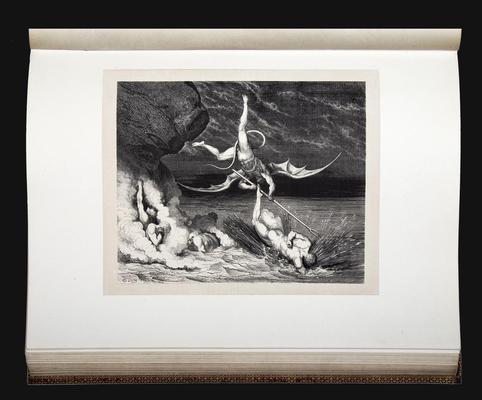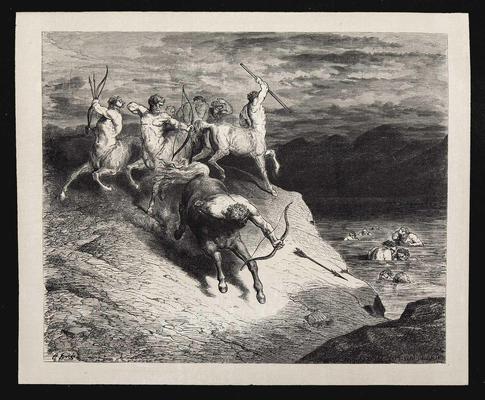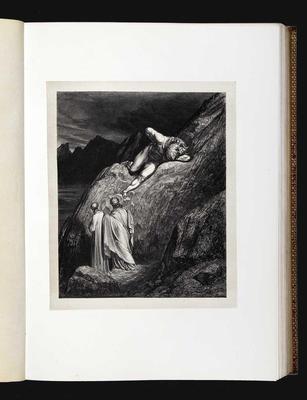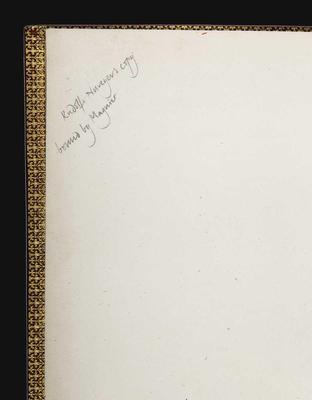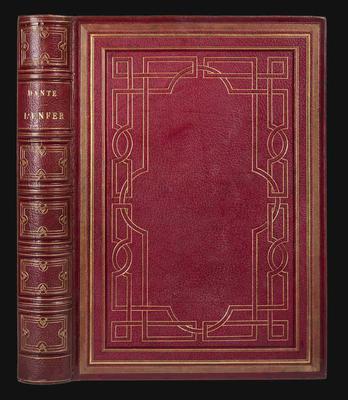Dante Alighieri
L’Enfer de Dante Alighieri. Avec le dessins de Gustave Doré. Traduction française de Pier-Angelo Fiorentino accompagnée du texte italien.
Paris, Librairie de L. Hachette et C.ie, 1861.Folio (420x302 mm). [4],iv, 194, [2] pages. Title-page in red and black. Dante's portrait as frontispiece. Seventyfive woodcuts after Gustave Doré, all protected by tissue paper with Dante's verses printed as captions on the recto. Late nineteenth-century gilt-tooled red morocco, signed by Charles Magnier. Covers within a border of fillets and interlaced ribbons. Spine with five raised bands, title lettered on second compartment. Marbled pastedowns and flyleaves; inside dentelles. Gilt edges. A very fine copy, with strong impression of the plates. Inserted in the volume is a loose page from La chronique illustrée no. 13, 6 November 1868, with a portrait of Doré, with the caption “Dessin de E. Penauille – Photographie de Nadar”.
Provenance: the Russian dancer Rudolf Nureyev (1938-1993); Livio Ambrogio collection.
The first issue of the Inferno illustrated with the seventy-five spectacular wood-block engravings designed by the famous painter and printmaker Paul Gustave Doré (1832-1883), and executed by around forty engravers.
In 1855 Doré planned to produce sets of illustrations for the greatest literary masterpieces of all time, and the Inferno was chosen to be the first in the series, reflecting Dante's wide popularity in France in the second half of the nineteenth century. Doré began to work in 1857, using Pier Angelo Fiorentino's French translation of the poem. The publishing costs were defrayed by Doré himself, and the commercial success of the volume was immediate: the reading public was impressed by the hallucinatory power and emotional intensity of the plates, which resemble paintings more than drawings, thanks to Doré's skilful handling of sfumato and chiaroscuro. In 1862 Hachette published a second issue of the Inferno. The complete series of plates executed by the French artist – forty-two for the Purgatorio and eighteen for the Paradiso – appeared only in 1868. Although Doré's production includes numerous illustrated literary works – Rabelais, Cervantes, Byron, and Poe among others – his name is most closely connected with his illustrations for the Commedia. The French artist often went back to these engravings as sources for paintings, and his Dante plates have also been a source of inspiration for many later artists, filmmakers and set designers. The influence of Doré's extraordinary and bizarre imagery is also detectable in the 1992 choreography of the ballet La Bayadère (The Temple Dancer), the last production mounted for the Paris Opéra by one of the greatest of all dancers, Rudolf Nureyev, the former owner of this copy.


